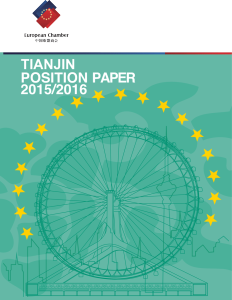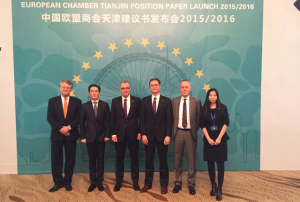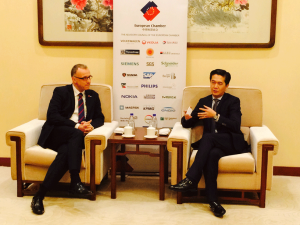The Tianjin Position Paper 2015/2016 is launched.
 The Chamber’s Tianjin Chapter has spent the last decade successfully facilitating positive relations between its members and the Tianjin Government to help improve the operational and investment environment for European companies invested in the city. It is apt, then, that as the Tianjin Chapter reflects on 10 years of advocacy efforts in Tianjin and the surrounding area, they launched the Tianjin Position Paper 2015/2016 as a standalone publication for the first time.
The Chamber’s Tianjin Chapter has spent the last decade successfully facilitating positive relations between its members and the Tianjin Government to help improve the operational and investment environment for European companies invested in the city. It is apt, then, that as the Tianjin Chapter reflects on 10 years of advocacy efforts in Tianjin and the surrounding area, they launched the Tianjin Position Paper 2015/2016 as a standalone publication for the first time.
Launched on 3rd March, 2016, the Tianjin Position Paper 2015/2016 provides a comprehensive overview of the challenges that European businesses based in Tianjin face on a daily basis, and makes recommendations to the Tianjin authorities that can help them to achieve their long-term goals and make Tianjin a more attractive destination for foreign investment.
After gaining particular prominence in the mid-19th century as a gateway to the nation’s capital, Tianjin is finally ready to outgrow its status as a stopover and become a key destination in its own right. Nowadays, Tianjin features one of the highest gross domestic product (GDP) figures in the country.[1] It enjoys a quasi-provincial status that guarantees unique access to and support from the central government and is home to the China (Tianjin) Pilot Free Trade Zone (CTPFTZ). It is also at the heart of the planned Beijing-Tianjin-Hebei (‘Jing-Jin-Ji’) megaregion, which, once realised, will cover 216,000km2 and will be home to more than 100 million people.[2]
 While current overall growth figures are encouraging, Tianjin’s efforts to reinvigorate the local economy are a relatively recent phenomenon: the State Council designated the Tianjin Binhai New Area (TBNA) a special economic zone to become the next economic engine for Northern China as recently as 2006. And while Tianjin and Beijing are, at least geographically, separated by just one thirty-minute train ride, the developmental gap between the two cities is far wider – since the early 2000s, Tianjin has continuously lagged behind Beijing in terms of overall contribution to China’s GDP.
While current overall growth figures are encouraging, Tianjin’s efforts to reinvigorate the local economy are a relatively recent phenomenon: the State Council designated the Tianjin Binhai New Area (TBNA) a special economic zone to become the next economic engine for Northern China as recently as 2006. And while Tianjin and Beijing are, at least geographically, separated by just one thirty-minute train ride, the developmental gap between the two cities is far wider – since the early 2000s, Tianjin has continuously lagged behind Beijing in terms of overall contribution to China’s GDP.
Historically, a number of factors have contributed to Tianjin’s lagging economy. These include China’s command economy, the decision to incorporate Tianjin into Hebei Province and the concurrent relocation of certain key industries away from the city. One of the key challenges it faces, though, is its proximity to the capital: the majority of resources have continuously flowed into Beijing, adversely affecting Tianjin’s growth. The TBNA is one initiative that the Tianjin authorities hope can help to reverse the trend, but with the slowdown of China’s overall economy it may prove to be too little too late. With this and other recent tools that have been put in place to jumpstart the local economy, will Tianjin be able to close the developmental gap and employ a long-term strategy to firmly establish Tianjin as a prime investment destination?
The way forward for Tianjin: the 3+1 model
In this time of transition, Tianjin’s local government has already launched a number of initiatives to further grow the local economy. These include investing in transportation infrastructure, the construction of a completely new ‘ecological district’ in Tianjin, the expansion of its port facilities and taking the first steps to improve overall living conditions.
 If Tianjin is to successfully move towards establishing itself as north China’s economic centre, the Tianjin Chapter believes that it must leverage its unique potential and focus on four key projects – what we call the ‘3+1’ model (three expansions and one integration):
If Tianjin is to successfully move towards establishing itself as north China’s economic centre, the Tianjin Chapter believes that it must leverage its unique potential and focus on four key projects – what we call the ‘3+1’ model (three expansions and one integration):
- Expand Tianjin’s overall quality of life: Tianjin must address two long-term problems – its air quality and the lack of public transportation options.
- Expand the TBNA and Tianjin Port: Even after the explosion in August, Tianjin remains a major seaport. In order to get back on track to becoming the most competitive in China it needs to return to the level of service it provided prior to the disaster, and then surpass it. It is an important hub in the national transportation system, an important foreign trade port for north China, and a key node in the modern transport network between Beijing, Tianjin and Hebei province. It is also a link between Northeast Asia and Middle and Central Asia. In order to release its full potential the TBNA should also be expanded and its regulatory infrastructure internationalised.
- Expand the Tianjin Free Trade Zone: The local authorities must safeguard transparency and compliance with regulations within the zone, and should encourage more input from foreign enterprises in formulating a future development strategy that will help it flourish.
- Integrate ‘Jing-Jin-Ji’: China is looking to the creation of megaregions such as ‘Jing-Jin-Ji’ to provide its future model for sustainable growth. If executed carefully, ‘Jing-Jin-Ji’ may further boost the local economy while providing solutions to some of China’s acute problems such as pollution, overcrowding, water-shortages and uneven development.
Tianjin finds itself at a critical juncture, but it has a number of unique tools at its disposal to maximise evenly-distributed, long-term growth that will allow it to finally close the developmental gap with Beijing and take advantage of its strategic location.
With Tianjin’s ambitious plan—established by the State Council—to become the economic centre of Northern China by 2020, it is anticipated there will be more growth and a corresponding amount of investment opportunities for the foreseeable future. The Tianjin Chapter hopes that the Tianjin Position Paper 2015/2016 will open fresh channels of communication with the local government, and that European Companies will be able to continue contributing to Tianjin’s development for many years to come.
Download a copy of the Tianjin Position Paper 2015/2016 in PDF format.
[1] Shanghai, Beijing and Tianjin Lead Country in per Capita GDP, The Economic Observer, 3rd February, 2012, viewed 12th June, 2015, <http://www.eeo.com.cn/ens/2012/0203/220140.shtml>
[2] Jing-Jin-Ji: The Biggest City in China You’ve Probably Never Heard Of, China Briefing, Dezan Shira & Associates, 11th July, 2014, viewed 9th November, 2015, <http://www.china-briefing.com/news/2014/07/11/jing-jin-ji-biggest-city-china-youve-probably-never-heard.html#sthash.TcjpMqsf.dpuf>


Recent Comments